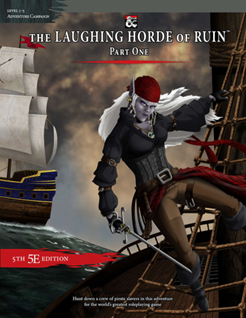 The Laughing Horde of Ruin is a campaign adventure that takes the adventurers on the road from the city of Raven’s Bluff to the city of Tsurlagol, a haven for pirates. Designed by James MacMurray, this is a 99-page adventure that takes characters from level 1 to level 5.
The Laughing Horde of Ruin is a campaign adventure that takes the adventurers on the road from the city of Raven’s Bluff to the city of Tsurlagol, a haven for pirates. Designed by James MacMurray, this is a 99-page adventure that takes characters from level 1 to level 5.
The adventure begins in Raven’s Bluff, where the adventurers are asked to find the son of the local barkeep; the son was living in Dragon Falls, but his wife has reported him missing. The journey to Dragon Falls uses set encounters rather than a random table, allowing more detail as to what occurs. However, several of these encounters are quests that divert the adventurers from their main objective. This doesn’t always make sense. If the adventurers are attacked by bandits, that’s one thing, but going on a side-quest and not concentrating on their main task seems odd. This section has interesting encounters, but many don’t fit into the structure of the overall storyline that well.
Once the adventurers reach Dragons Falls, they get to interact with the locals. It’s not just the innkeeper’s son who is missing! The adventurers must explore a couple of dungeons to find them. One dungeon is a false lead, but it has information that leads to the true path. Eventually, it’s hoped that the party rescue the innkeeper’s son, and the adventure ends successfully.
But wait! There’s more!
There are goblin slavers to deal with, and, after that, the people who have organised them! More dungeons, then a city – and its sewers. Finally, there’s a sea battle. There’s a lot of different encounters in this adventure!
The dungeons tend to be realistic rather than fantastic, although there exist items of wonder. This is an adventure that features the ruins of previous settlements: a lost dwarven settlement and the old ruins underneath Tsurlagol. The author appreciates the effect of empty rooms, and there are notes for the original purpose of each. This should aid DMs in creating the verisimilitude of the world.
There are occasional problems with encounter triggers and structure. A rogue steals the gold from the party, regardless of how they conceal it. How did he even know about the gold? The action when it gets to Tsurlagol is convoluted in the extreme. You can see how the adventure has been written as a linear (railroaded) experience, and then the author has wrestled with the adventure to make it more non-linear. It doesn’t always work, and it’s painful to see it in Tsurlagol. The designer wants you to go into a dungeon, but the hook is weak – “if you find this jewel for me, I’ll release all the slaves”. Would you trust a slaver? I certainly wouldn’t. The alternative is to negotiate with the local council. Spying? Intrigue? Buying information off contacts to find the slaves? These avenues of approach aren’t covered. This is one time when I want a sandbox-like approach, but the focus on the dungeon prevents this. There aren’t even other reasons to go into the dungeon – just this one NPC.
The adventure also suffers greatly from being overwritten or poorly phrased. The adventure’s structure isn’t always obvious, and I found it quite difficult to read. I had the adventure for several weeks, and each time I thought I’d prepare for the review, I’d read a few paragraphs and find something else to do. I’d have appreciated shorter sentences with fewer clauses. In addition, some of the boxed text makes assumptions about the actions of the characters or how they’re feeling, something I prefer not to see.
The layout is fine, the maps are nice. The product doesn’t use much art, but I didn’t notice its lack.
Overall, there’s good material in the adventure, but lapses in how it was structured do it no favours.
